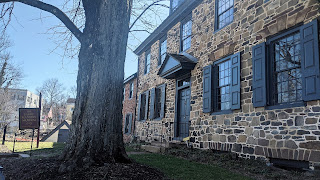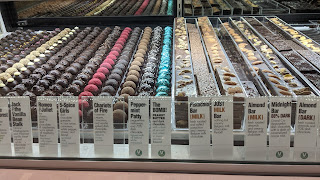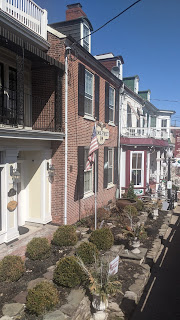 |
| The historic Reading Pagoda was completed in 1908 and was intended to be a luxury resort atop Mt. Penn, but due to a bank foreclosure and denial of a liquor license, it never was opened. |
I’m sure I’m not alone in looking forward to traveling this
summer, but doesn’t it figure that once things begin to return to a semblance
of normal, we end up with higher gas prices? If the price of gas has you down,
you may want to consider exploring closer to home. I travel quite a bit and
still marvel at what I have yet to experience in our area. A recent trip to
Berk’s county took me to a Hawk Sanctuary, a renovated train-station turned
restaurant, a Barn Star Art Tour, a train trip on a renovated railroad, a museum,
an art collective and a cave that has been a tourist destination for 145 years.
These destinations were all new to me and I was able to see them all on one
tank of gas.
Hitting the Open Road
If you’re not quite up to mingling with crowds yet, you can
take a scenic ride through rural Berks county on a self-guided Barn Star Art
Tour, make a stop at Crystal Cave and continue on to Hawk Mountain.
Barn stars, otherwise known as “hex signs,” are a type of
Pennsylvania Dutch Folk Art. According to Patrick Donmoyer, Director of the
Pennsylvania German Cultural Heritage Center at Kutztown University, the
designs are first and foremost artistic, but they tell of the culture’s
interest in the heavens and the cosmos. One of the artists featured on the tour
is Milton Hill, who began painting at the age of 14 under the tutelage of his
father and grandfather. “He was extremely elaborate and created designs that
were previously less complex,” said Donmoyer. Hill is just one of many artists
whose work can see along the trail. According to Donmoyer, the tour traverses
about 40 miles and can be completed in about an hour and 15 minutes.
 |
| The Sunday Barn in Virginville features artwork by Milton Hill. |
Three miles into the tour, guests will arrive at Crystal
Cave, which attracts thousands of visitors every year. A 55-minute guided tour
begins with an educational film called, “Inside the Earth. Afterwards, a tour
guide leads guests are through the cave, pointing out fascinating rock
formations comprised of stalactites, stalagmites, flowstone and more. One
interesting fact pointed out by the guide: A wedding reception once took place
there. I researched this later and a photo of the bride and groom can be found
on the internet. Even more implausible is that a piano was somehow lugged there.
After climbing several dozen steps and getting plenty winded while making my
way to the cave, I wonder how they managed.
 |
| View of outbuildings from atop the hill at Crystal Cave |
 |
| Interior rooms at Crystal Cave |
 |
| Crystal Cave giftshop |
A small detour along the Barn Star Art Tour will take visitors to
Hawk Sanctuary in Kempton, which features a visitor’s center, eight miles of
trails and beautiful vistas. From August
15 through December 15, staff and volunteers are stationed at lookouts to help
visitors spot hawks, eagles, falcons and vultures. Annual counts for this
four-month period average 18,000 raptors.
 |
| I wish I would have seen more hawks when I visited, but the vistas were beautiful |
.
Activities for Art Lovers
 |
| Seward Johnson's "Calling Girl" |
The Reading Public Museum features science, history and art displays, a planetarium with children and adult programming and a 25-acre arboretum open daily from sunrise, to sunset. The fine art collection includes 700 oil paintings by
American and foreign artists. Rodin, Picasso, Monet and Degas are among their
collection, as are contemporary artists like Warhol, Chihuly and native son
Keith Haring.
 |
| Elton John with Billy Jean King |
 |
| Outfit worn by Rosie Casals on the Virginia Slim circuit, 1975 |
Special exhibits rotate seasonally. When I visited, women’s
tennis fashion was the focus and represented by the Seward Johnson statue
greeting guests at the entrance. After seeing many Seward Johnson works at the
Gardens for Sculpture in New Jersey, I learned that it’s easy to spot them.
There’s also one (of Abe Lincoln) on the square in Gettysburg, Pennsylvania.
 |
| Large girl reading, by Henri Matisse, 1923 |
What I also found interesting is that the Neag Planetarium
is featuring Floyd Final Fridays for Pink Floyd fans like myself, with shows
occurring at 8, 9 and 10 on various Fridays throughout September. That would
have been something I would have enjoyed had I known about it prior to my visit.
Children’s programming is also featured throughout the week. Check their
website for information and times.
The Goggleworks Center for the Arts gets its name from a
goggle factory that operated at the site from 1871-2002. Today it is a 145,000 square foot community
art and cultural center that offers art classes in various mediums, from glass,
to metals, paint, ceramics and more. A community art room enables both amateur
and professionals to work side by side, ostensibly to learn from each other. While
I was there, I tried my hand at making a glass flower in their glass blowing
area, with a little help from the staff.
 |
| Flower making in the glass shop. |
 |
| Amateurs and professionals work side by side at Goggleworks. |
 |
| Steampunk artwork by Julio Cesar Cepeda Duque |
 |
| Some of my favorites by David Bogus--these are ceramic suitcases. |
 |
| More from David Bogus |
 |
| A separate room tells the story of Wilson Goggles, which used to be produced onsite. |
Visitors are welcome to tour the facility free of charge and
view the work of the many talented artists who create there. Also onsite at the
Center is the 130-seat Albert and Eunice Boscov Film Theatre, which shows
arthouse and international films.
 |
| The Albert and Eunice Boscov Film Theatre |
Good Eats
 |
| Folino's retail store and tasting room. |
 |
| Cucina Cafe |
 |
| A selection of wines we chose to bring home with us. |
 |
| Cucina Cafe |
 |
| Antipasto salad. |
Folino Estate Vineyard, Winery and Restaurant near Kutztown
is run by a family who has 40 years of experience in the restaurant industry.
Guests can taste award-winning wines in their tasting room from Wednesday
through Sunday, then walk over to the Cucina Café located in the same building
for pizza, pasta, salads and more. If you love your lasagna extra cheesy, you
can’t go wrong ordering it here.
For a bit of nostalgia, grab a bite at Jimmie Kramer’s
Peanut Bar and Restaurant in downtown Reading, where little has changed over
the decades, not least of which is the outdoor sign with the smiley peanut man
wearing pants, bowtie and suspenders overlooking cursive lettering spelling out
Jimmie Kramer’s name. Jimmie Kramer’s dates back to 1933 and lays claim to
being one of the first restaurants to serve peanuts and invite guests to throw
the shells on the floor. The story has it that Jimmie always wanted to give his
guest a little something extra, a lagniappe, of sorts, so when he ran out of
pretzels, he asked an employee to run across the street to a peanut roaster and
a trend was created. Menu items include
steaks, seafood, wings and other American fare.
 |
| Jimmie Kramer's Peanut Bar dates back to 1933. |
To dine in a unique and beautiful setting, there’s the
Saucony Creek Craft Brewery + Pub located in the restored Reading Railroad
Franklin Street Station, which was built in the 1930s in the Renaissance
Revival Architectural style. Its soaring windows, ornate details and terrazzo
floors make it something special to see and if a train passes by, expect all
the diners to stand up and clap; it’s a tradition.
 |
| Saucony Creek Craft Brewery + Pub operates in a repurposed train station. |
Take a Ride on The Coalbrookdale Railroad
Continuing with the railroad theme is the tourist
destination located in Boyertown that takes visitors on a scenic, roundtrip ride
from Boyertown, to Pottstown. The railroad boasts some of the most beautiful
railcars you’ll ever see, with stained-glass windows and a wealth of little details
designed to give the passenger a feeling of opulence.
 |
| White tablecloth service aboard the Coalbrookdale Railroad. |
Guest Relations Manager Nathan Labb said that non-profit
rescued some of the cars from Canada and the project started out with one
diesel, a coach and a caboose. Today there are six cars in service, three on
the property and three awaiting restoration. According to Labb, the cars
underwent a restoration taking between 1,000 and 2,000 man-hours to complete. “It
took us about three years to get everything running and this is our seventh
year of tourist operations,” said Labb, adding that restorations are covered by
ticket sales, private donations and state and federal grants. A particularly
busy time for the railroad is on Mother’s Day when families take mom out to eat
brunch and dinner aboard comfortable surroundings made even more special by
white tablecloths and fresh flowers.
The tour presentation highlights the importance of the early iron works which flank the railroad tracks for nearly the entire distance of the line.
Accommodations
My husband and I stayed at the Reading Doubletree by Hilton,
which is located near the Santander Arena, a half mile from Goggleworks and two
miles from the famous Reading Pagoda, (completed in 1908 and intended to be a
luxury hotel/restaurant for a resort that never came to fruition).
We enjoyed our stay there and can highly recommend the
hotel. Not only was the manager a presence (he greeted us within a few minutes
after we checked in), but we also saw him meeting with his staff often to ask
what they had done that day to make guests comfortable. Another service, of which we took advantage, was the shuttle
to various places, like Jimmie’s and Saucony Creek.
The above suggestions should keep the most ambitious
traveler busy for a while, or at least for a long weekend. To learn more about
what to see and do in the Reading area, visit Pennsylvania’s Americana Region
website at https://visitpaamericana.com/.





































































